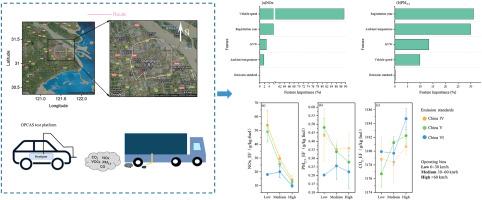真实世界柴油卡车的排放特征和驱动因素:来自羽流追逐实验的见解
IF 3.4
Q2 ENVIRONMENTAL SCIENCES
引用次数: 0
摘要
公路运输正逐渐成为中国空气污染物和碳排放的主要来源之一。本研究以上海地区487辆柴油车为研究对象,利用移动烟羽追踪分析系统进行了尾气追踪实验,获取了实际空气污染物和二氧化碳的排放特征。被测车辆氮氧化物(NOx)、细颗粒物(PM2.5)、挥发性有机物(VOCs)和一氧化碳(CO)的平均排放因子(EFs)分别为22.8±13.5、0.38±0.26、5.6±4.9和4.5±4.0 g/kg燃料。从国四到国六观察到的空气污染物EFs的减少表明,更严格的排放标准与柴油卡车车队排放减少之间存在潜在的相关性。此外,EFs随车辆总重(GVW)的增加而增加。车速、登记年份和风向是氮氧化物排放的主要驱动因素。实测的CO2 EFs为3182.2±5.8 g/kg燃料,与排放标准和GVW变化不大,与上述空气污染物不同。我们发现CO2和NOx的EFs之间存在显著的负相关(p <;0.05),说明随着NOx排放量的减少,CO2排放量有增加的趋势。因此,我们建议将二氧化碳排放限制纳入新的标准,以实现污染物和温室气体的协同控制。本文章由计算机程序翻译,如有差异,请以英文原文为准。

Real-world emission characteristics and driving factors of diesel trucks: Insights from plume chasing experiments
On-road transportation is gradually becoming one of the major source contributors to air pollutants and carbon emissions in China. In this study, a chasing experiment was conducted on 487 diesel trucks in Shanghai using a mobile plume chasing and analysis system to obtain the real-world emission characteristics of air pollutants and carbon dioxide (CO2). The average emission factors (EFs) of nitrogen oxide (NOx), fine particulate matter (PM2.5), volatile organic compounds (VOCs) and carbon monoxide (CO) of the measured vehicles are 22.8 ± 13.5, 0.38 ± 0.26, 5.6 ± 4.9, and 4.5 ± 4.0 g/kg fuel, respectively. The observed decrease in EFs of air pollutants from China IV to China VI suggests a potential correlation between stricter emission standards and reduced emissions in diesel truck fleets. Additionally, the EFs increase with the gross vehicle weights (GVW). The driving speed, registration year and wind direction were the main drivers of NOx EFs. The measured CO2 EFs is 3182.2 ± 5.8 g/kg fuel, showing little variations with emission standards and GVW, which is different from the abovementioned air pollutants. We found a significant negative correlation between the EFs of CO2 and NOx (p < 0.05), indicating that as NOx emissions decrease, CO2 emissions tend to increase. Therefore, we recommend integrating CO2 emission limits into new standards to achieve synergistic control of pollutants and greenhouse gases.
求助全文
通过发布文献求助,成功后即可免费获取论文全文。
去求助
来源期刊

Atmospheric Environment: X
Environmental Science-Environmental Science (all)
CiteScore
8.00
自引率
0.00%
发文量
47
审稿时长
12 weeks
 求助内容:
求助内容: 应助结果提醒方式:
应助结果提醒方式:


